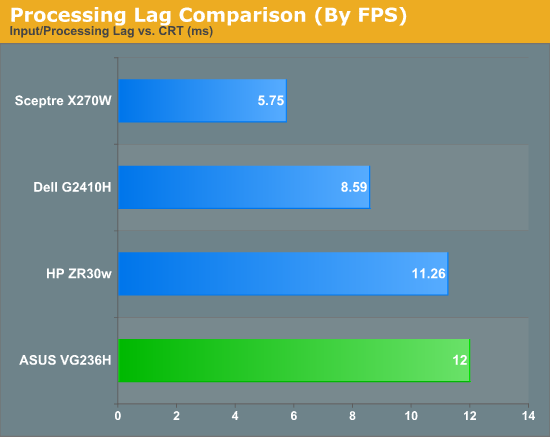ASUS VG236H 23-inch 3D Display Review: 120Hz is the Future
by Brian Klug on August 7, 2010 2:48 AM ESTProcessing and Input Latency
Processing and display lag is a very important thing for gamers, and it’s most often nebulously reported if at all. We’ve discussed this in previous display reviews, but what matters most is how the display acts in real world testing. I’ve been doing previous tests by comparing LCDs with first a 17” Princeton CRT, then a Sony G520 20” CRT.
So far the results have been a bit interesting, with the CRT barely edging out over the LCD. I did the same thing with the VG236H.
Jarred and Anand both warned me right after my first attempt with this method that we were probably going to see a difference purely because we’re comparing an analog VGA signal for the CRT to the DVI signal for the LCD in test. The problem being that because of the way we test, it’s likely the VGA and DVI paths get different frames from the framebuffer entirely. In addition, because I had the Zotac GTX 470 instead of the ATI Radeon HD5870 like previous tests, there’s another element of change here.
I ran through the tests as usual and measured the difference between the CRT at 75Hz (its maximum, seriously), and the VG236H at 120Hz running the 3Dmark Wings of Fury benchmark on constant loop. The ASUS comes in about 12ms behind the CRT after collecting 14 different samples.

I used the VG236H to play a number of FPS games during my time with it, and never noticed perceptible input lag. I’m convinced there’s something else at play here.
Remember how I mentioned the display has overdrive, er... “trace free” controls? By default, outside of 3D mode, trace free is set to 60. I decided to test at 100 and 0, effectively with overdrive on maximum, and off entirely. Turning overdrive off adds a repeatable 2.2ms of display latency after 20 data points.
More importantly, it effectively reduces the number of ghost images captured from two (one trailing, one preceding), to one (just trailing). Now you can understand why ASUS probably sets overdrive to maximum in 3D mode and keeps you from touching it, to virtually guarantee no ghosting or weird artifacts.
While we’re on that subject, I’ll note that I only noticed ghosting once while playing Metro 2033 start to finish in 3D with the VG236H, and even then I first thought it was something reflecting weird in the glasses. I’ve read about other displays having very obvious ghosting - you’d be hard pressed to find that with the VG236H.
I wasn’t entirely convinced that the VG236H had more input lag than any display I had tested previously, so I decided to test against a display I’m pretty fond of - my BenQ FP241W. Now, what about how the VG236 compares to it?
The VG236H consistently lags 1 frame from the FP241W, regardless of FPS, across about 40 photos I captured of the two displays. It’s always exactly one frame behind.
So what does that mean? Well, we’re likely seeing the difference between the 60Hz refresh rate of the FP241W and the 120Hz refresh rate of the VG236H. The higher refresh rate lets the ASUS show more frames than the FP241W, giving us more granularity. It just so happens that it’s pulling one frame behind, which on average worked out to a lag of 1.9 ms.
Further, Jarred tested the FP241VW which is essentially the exact same monitor as the FP241W but in a different enclosure, and measured input processing lag to be 2 ms compared to the famous HP LP3065 (which has no scaler and no input lag). Thus, a more accurate number for input lag on the ASUS VG236H is the sum of the two, at a much more respectable 3.9ms.













121 Comments
View All Comments
synaesthetic - Monday, August 9, 2010 - link
If your livelihood depends on color accuracy, you can damn well bet it's worth spending money on. Monitors cheaper than $300 have terrible color reproduction.Seikent - Saturday, August 7, 2010 - link
I have the Samsung 2233RZ monitor (120 hz, 3d ready, 16:10), it is a bit cheaper than this one, but it has some limitations.I don't have the shutter glasses, but I don't care too much because I don't have a Nvidia card. I bought it just because the 120 hz refresh rate. Playing with vsync on is awesome, the visual experience is much better, it feels fluid and it is hard to go back. It is hard to understand because you can't see it how it feels without having this monitor in front of you. I recommend you to try one.
JGabriel - Saturday, August 7, 2010 - link
Brian King: "I’d say the vertical angle you get isn’t quite as advertised, but honestly if you’re viewing the monitor from so far down below that this is noticeable, you’re probably doing something wrong ..."Or viewing it in portrait mode after attaching it to a pivot arm. Really, Brian, that should have occurred to you, as you bragged about "rolling your own" only a few paragraphs earlier.
.
JGabriel - Saturday, August 7, 2010 - link
Whoops, sorry for getting your last name wrong, Brian. I mis-read it somehow. Apologies..
Brian Klug - Saturday, August 7, 2010 - link
I agree, but the primary weird viewing angle is from below. From above, it seems much better (like many other TN panels, which is quite typical). I've encountered exactly that issue before putting a TN panel in portrait, and it definitely isn't desirable.I would definitely not recommend doing that with this ASUS ;)
-Brian
FH123 - Saturday, August 7, 2010 - link
Are 3D games, like Metro 2033, any better than what we get to see at the cinema? I saw Avatar (the film) and thought the 3D effects were laughable. In many scenes I could discern at most 3 or 4 planes of depth and, within those planes, everything looked flat. For example there might be a computer monitor in the foreground, then Sigourney Weaver, then the background. Where 3D worked it was mostly when things popped into the foreground, but the actors faces and backgrounds usually looked completely flat. South Park immediately sprang to mind. The actors looked like cardboard cut-outs in front of a background picture.Am I the only one noticing this effect? I admit my experience is very limited, as I walked out of Avatar half-way through and haven't watched anything 3D since. Nor do I have the desire to. The 3D effect was jarring and the film lost much of it's brightness, contrast and color saturation. What's the point? I own a good (JVC) projector. Something well recorded and not over-processed like, say, Treme (the TV series), looks far better to me than what I saw at the cinema that day. Depth perception, in that case, comes from low black-levels and proper dynamic range. Less dramatic, but it seems better to me.
Having said that, perhaps there is some advantage games have over films, even films that rely heavily on CGI, such as Avatar? Do they, perhaps by virtue of having a depth coordinate for every pixel on the screen, give a better continuity of depth perception?
Brian Klug - Saturday, August 7, 2010 - link
I agree with you, so that weird senstation is partly an artifact of 3D being added in after the fact, and partly just poor cinematography.The nice thing about games is that the 3D models are there already and have much finer meshes. I'd say that on the whole, no, that experience of things only existing in a few planes of depth is completely absent from gaming in 3D in any of the games I've tested thus far.
-Brian
nvmarino - Saturday, August 7, 2010 - link
Brian, great review, thanks!One of the benfits of a true 120Hz display (120Hz at the input) you didn't mention are the benefits for HTPC usage - a framerate that's evenly divisible by 60 and 24 means you can output both 24fps and 60fps content without having to change the refresh rate in the video card settings. Any chance you can confirm if the monitor supports HDCP on the DVI input? Also, any chance you could see if the commercial Blu-ray players (i.e. PowerDVD, TMT3, and WinDVD) play nice when outputting @120hz? Would also be good to know if Windows Media Center has any issues when outputting @120Hz as well!
Also, one minor gripe about your review - I think you're incorrectly referring to the system you're testing as "3D Vision Surround". "3D Vision *Surround*" is when using 3D Vision with multiple displays. Since you're reviewing with a single display it's just "3D Vision"...
Brian Klug - Saturday, August 7, 2010 - link
Excellent catch on 3D Vision Surround versus 3D Vision, fixed that!I'll test to make sure, but I'm 90% certain that it supports HDCP. It'd be absolutely unforgivable to be shipping a monitor in 2010 without HDCP. Having HDMI onboard pretty much guarantees that at least that input does, but I'll double check. I don't expect any problems though.
-Brian
Brian Klug - Saturday, August 7, 2010 - link
Just tested with PowerDVD 10 Mark II Version 10.0.1830.51 and playback is perfect - tried a variety of BD titles. Looks good at 120Hz (no stuttering). HDCP apparently does work over the DVI-D datapath.-Brian